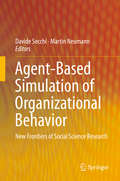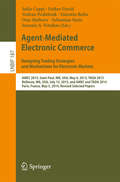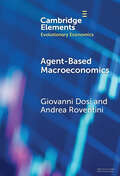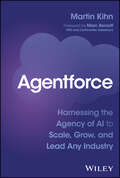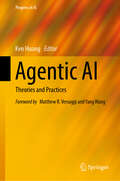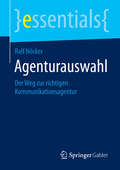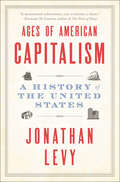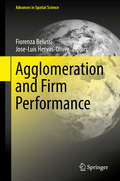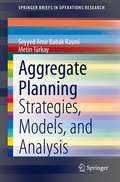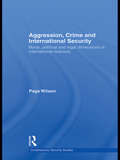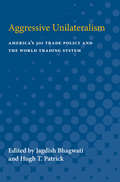- Table View
- List View
Agent-Based Simulation of Organizational Behavior: New Frontiers of Social Science Research
by Davide Secchi Martin NeumannThe aim of this book is to demonstrate how Agent-Based Modelling (ABM) can be used to enhance the study of social agency, organizational behavior and organizational management. It derives from a workshop, sponsored by the Society for the Study of Artificial Intelligence and the Simulation of Behavior (AISB), held at Bournemouth University Business School in 2014 on "Modelling Organizational Behavior and Social Agency". The contents of this book are divided into four themes: Perspectives, Modeling Organizational Behavior, Philosophical and Methodological Perspective, and Modeling Organized Crime and Macro-Organizational Phenomena. ABM is a particular and advanced type of computer simulation where the focus of modeling shifts to the agent rather than to the system. This allows for complex and more realistic representations of reality, facilitating an innovative socio-cognitive perspective on organizational studies. The editors and contributing authors claim that the use of ABM may dramatically expand our understanding of human behavior in organizations. This is made possible because of (a) the computational power made available by technological advancements, (b) the relative ease of the programming, (c) the ability to borrow simulation practices from other disciplines, and (d) the ability to demonstrate how the ABM approach clearly enables a socio-cognitive perspective on organizational complexity. Showcasing contributions from academics and researchers of various backgrounds and discipline, this volumes provides a global, interdisciplinary perspective.
Agent-Based Strategizing (Elements in Business Strategy)
by Duncan A. RobertsonStrategic management is a system of continual disequilibrium, with firms in a continual struggle for competitive advantage and relative fitness. Models that are dynamic in nature are required if we are to really understand the complex notion of sustainable competitive advantage. New tools are required to tackle challenges of how firms should compete in environments characterized by both exogeneous shocks and intense endogenous competition. Agent-based modelling of firms' strategies offers an alternative analytical approach, where individual firm or component parts of a firm are modelled, each with their own strategy. Where traditional models can assume homogeneity of actors, agent-based models simulate each firm individually. This allows experimentation of strategic moves, which is particularly important where reactions to strategic moves are non-trivial. This Element introduces agent-based models and their use within management, reviews the influential NK suite of models, and offers an agenda for the development of agent-based models in strategic management.
Agent-Mediated Electronic Commerce. Designing Trading Strategies and Mechanisms for Electronic Markets: AMEC 2013, Saint Paul, MN, USA, May 6, 2013, TADA 2013, Bellevue, WA, USA, July 15, 2013, and AMEC and TADA 2014, Paris, France, May 5, 2014, Revised Selected Papers (Lecture Notes in Business Information Processing #187)
by Esther David Onn Shehory Sofia Ceppi Verdan Podobnik Valentin Robu Sebastian Stein Ioannis A. VetsikasThis volume contains 12 thoroughly refereed and revised papers detailing recent advances in research on designing trading agents and mechanisms for agent-mediated e-commerce. They were originally presented at three events: the Workshop on Agent-Mediated Electronic Commerce (AMEC 2013), co-located with AAMAS 2013 in Saint Paul, MN, USA, in May 2013; the Workshop on Trading Agent Design and Analysis (TADA 2013), co-located with AAAI 2013 in Bellevue, WA, USA, in July 2013; and the Joint Workshop on Trading Agent Design and Analysis (TADA 2014) and Agent-Mediated Electronic Commerce (AMEC 2014), co-located with AAMAS 2014 in Paris, France, in May 2014. Given the breadth of research topics in this field, the range of topics addressed in these papers is correspondingly broad. These include the study of theoretical issues related to the design of interaction protocols and marketplaces; the design and analysis of automated trading strategies used by individual agents; and the deployment of such strategies, in times as part of an entry to the trading agent competition.
Agent-based Macroeconomics: The Schumpeter Meeting Keynes Models (Elements in Evolutionary Economics)
by Giovanni Dosi Andrea RoventiniThis Element is about agent-based macroeconomics in general, and in particular about a family of evolutionary, agent-based models (ABMs), which are called 'Schumpeter meeting Keynes' (or K+S). The K+S models knit together 'Schumpeterian' endogenous processes of innovation with 'Keynesian' mechanisms of demand generation. As with all well-constructed ABMs, the K+S models are populated by a multiplicity of agents which interact on the grounds of quite simple, empirically based, behavioural rules, whose collective outcomes are 'emergent properties' which cannot be imputed to the intention of any single agent. After the K+S model is empirically validated, the impacts of different combinations of innovation, industrial, fiscal, and monetary policies for different labour-market regimes and inequality scenarios are assessed. The Element offers a new perspective on macroeconomics considering the economy as a complex evolving system.
Agent-based Models of the Economy
by Angela Testi Riccardo Boero Matteo Morini Michele Sonnessa Pietro Terna Elena Tànfani Simone PellegrinoAgent-Based Models Of The Economy uses agent-based models for understanding a broad spectrum of economic phenomena. This book aim is twofold. First, it introduces the reader to the methodology and to the technicalities and the tools necessary to master the creation of agent-based models. Second, it presents several examples of applications to different economic phenomena where agent-based models are crucial in answering the research question and in solving practical problems emerged in business and policy domains (e. g. , financial markets, cooperation dynamics, public policy evaluation). With this book, readers learn what agent-based models are and the advantages they can provide. Further, readers learn how to develop from scratch and with scientific rigor their own agent-based models for studying economic phenomena. Finally, readers find in the book several applications that can represent examples to be imitated and to be kept as reference.
Agentenbasierte Modellierung: Eine interdisziplinäre Einführung (essentials)
by Silvio Andrae Patrick PobudaMit Hilfe der agentenbasierten Modellierung (ABM) lassen sich komplexe Systeme wie Finanzmärkte, Gesellschaften, Infrastrukturnetze, Organisationen oder ähnliches detailliert darstellen und anschließend realitätsnah simulieren. Aufgrund der zentralen Fähigkeit der ABM, das Zusammenspiel einer Vielzahl heterogener Agenten miteinander sowie mit ihrer Umgebung recht einfach zu modellieren, können Phänomene auf der Makroebene durch Ereignisse auf der Mikroebene verständlich erklärt, zuverlässig prognostiziert oder auch in experimenteller Weise erkundet werden. Diese computergestützte Methode bietet zahlreiche Vorteile, weshalb sie heutzutage bereits in vielen Anwendungsbereichen erfolgreich eingesetzt wird. So kann beispielsweise, abhängig von der gewählten Modellierungsumgebung bzw. der verwendeten Software, eine grundlegende Einarbeitung ohne größeren Zeitaufwand und vor allem auch ohne entsprechende Programmierkenntnisse autodidaktisch geschehen. Diese interdisziplinär angelegte Einführung ermöglicht einer breiten Zielgruppe einen Einblick in die Grundlagen der ABM.
Agentforce: Harnessing the Agency of AI to Scale, Grow, and Lead Any Industry
by Martin KihnIntroducing AI agents, the groundbreaking third wave of AI's integration in the workforce Agentforce: Harnessing the Agency of AI to Scale, Grow, and Lead Any Industry tells you how companies can create and control their own AI agents and build a virtual workforce. It goes behind-the-scenes on how Salesforce built a platform to drive AI agents, solving problems like hallucinations and bias through a framework that gives agents strict roles, data sources, actions, guardrails and channels to reach customers. This book draws from extensive research and exclusive access to Salesforce's leaders and their ambitious plan to dominate the race to develop and own the AI agent space. In this book, readers will find information on: AI agents as a “third wave” of AI development that goes far beyond simple chatbots and "co-pilots" through harmonized data, Retrieval Augmented Generation (RAG), and Salesforce's innovative Atlas Reasoning Engine Steps to develop prompt guidance, topic creation (areas of work), explicit instructions, and a menu of actions allowed Salesforce customers, such as Saks and OpenTable, that are already using AI agents with success The effects of AI and automation on the job market Agentforce: Harnessing the Agency of AI to Scale, Grow, and Lead Any Industry is an indispensable, forward-thinking resource on the subject for all leaders in business seeking to supercharge their organizations' initiatives through the latest developments in a rapidly advancing field.
Agentic AI: Theories and Practices (Progress in IS)
by Ken HuangThis book analyzes the rise and transformative impact of generative AI agents or Agentic AI across industries, offering a comprehensive exploration of their development, applications, and implications. It highlights how these systems are revolutionizing business processes, enhancing decision-making, and reshaping entire sectors from finance to healthcare. It traces the evolution of AI agents from early programs to today&’s sophisticated autonomous systems, providing a taxonomy of agent types. It then explores cutting-edge tools and frameworks for development, such as AutoGen, Langgraph, and CrewAI, offering practical insights for their deployment. Key focus areas include evaluating multiagent systems and coordination techniques, addressing challenges in communication, and conflict resolution. The book presents case studies from banking, insurance, healthcare, and cybersecurity, showcasing how autonomous agents are automating tasks and driving innovation. In turn, the book provides in-depth analyses of Agentic AI in emerging fields like gene editing, robotics, and business process automation, demonstrating its potential to accelerate scientific research and value creation. The discussion extends to economic ramifications, examining impacts on macroeconomic trends, microeconomic dynamics within businesses, and the emergence of decentralized, token-based economies. Throughout, thought-provoking questions encourage readers to consider the broader implications of these technological advances. The work concludes with a critical examination of related safety and security considerations, emphasizing the need for proactive measures. Maintaining a forward-looking perspective, it prompts readers to consider how these technologies might reshape industries and society, raising important questions about the changing nature of work, ethical aspects, and equitable distribution of benefits. Bridging theoretical foundations and practical applications, the book offers valuable insights for data scientists, IT managers, CIOs, CAIOs, CTOs, business analysts, and graduate students seeking to understand and apply AI&’s transformative potential across various industries.
Agents of Reform: Child Labor and the Origins of the Welfare State (Princeton Studies in Global and Comparative Sociology)
by Elisabeth AndersonA groundbreaking account of how the welfare state began with early nineteenth-century child labor laws, and how middle-class and elite reformers made it happenThe beginnings of the modern welfare state are often traced to the late nineteenth-century labor movement and to policymakers’ efforts to appeal to working-class voters. But in Agents of Reform, Elisabeth Anderson shows that the regulatory welfare state began a half century earlier, in the 1830s, with the passage of the first child labor laws.Agents of Reform tells the story of how middle-class and elite reformers in Europe and the United States defined child labor as a threat to social order, and took the lead in bringing regulatory welfare into being. They built alliances to maneuver around powerful political blocks and instituted pathbreaking new employment protections. Later in the century, now with the help of organized labor, they created factory inspectorates to strengthen and routinize the state’s capacity to intervene in industrial working conditions.Agents of Reform compares seven in-depth case studies of key policy episodes in Germany, France, Belgium, Massachusetts, and Illinois. Foregrounding the agency of individual reformers, it challenges existing explanations of welfare state development and advances a new pragmatist field theory of institutional change. In doing so, it moves beyond standard narratives of interests and institutions toward an integrated understanding of how these interact with political actors’ ideas and coalition-building strategies.
Agents' Preferences, the Equity Premium, and the Consumption-Saving Trade-Off: An Application to French Data1
by Anne Epaulard Aude PommeretThis paper aims to measure the risk premium on French equities during 1960-92 and to evaluate how well theoretical models based on various representations of agents' preferences can explain it. Aside from the standard, time-additive utility function with constant relative risk aversion, three other utility functions are reviewed: a recursive utility function, a habit formation utility function, and a utility funtion that accounts for the interdependence of preferences. Both calibration and econometric estimations show that none of the studied marginal changes in the representation of agents' preferences are sufficient to solve both the equity premium puzzle and the risk-free rate puzzle.
Agenturauswahl im Marketing: Anforderungen formulieren, Pitches auswerten, Verhandlungen führen – So finden Unternehmen den optimalen Partner
by Jens ErichsenDieses Buch bietet Unternehmen einen praxisnahen und wissenschaftlich fundierten Leitfaden für den gesamten Agenturauswahlprozess: von der Anforderungsanalyse über geeignete Verfahren, Verhandlungen und Vertragsgestaltung bis hin zur finalen Entscheidung. Die Agenturauswahl ist eine der strategisch wichtigsten Entscheidungen im Marketing – und wird dennoch oft emotional, unstrukturiert und ineffizient umgesetzt. Der Autor zeigt, wie Sie typische Beobachtungsfehler vermeiden, strukturierte Bewertungen vornehmen und Tools gezielt einsetzen. Auch psychologische Fallstricke und Grundlagen werden erläutert; erprobte Methoden und hilfreiche Checklisten ergänzen das Werk. Ein wertvoller Begleiter für Marketingentscheider, Markenverantwortliche, Pitch-Berater und Einkäufer in Unternehmen, die ihre Prozesse professionalisieren, Zeit und Kosten sparen und die beste Agentur finden wollen – fundiert, transparent und wirkungsvoll auf nachhaltigen Erfolg ausgerichtet.
Agenturauswahl: Der Weg zur richtigen Kommunikationsagentur (essentials)
by Ralf NöckerRalf Nöcker liefert einen Überblick über den Agenturmarkt und zeigt auf, dass der Auswahl einer passenden Kommunikationsagentur allergrößte Bedeutung zukommt. Häufig wird sie, was Tragweite und Aufwand betrifft, verglichen mit der Besetzung einer Top-Führungsposition im Unternehmen. Der Autor stellt eine Übersicht der Auswahlkriterien, Berichte von Praktikern aus Marketing, Einkauf und Agentur sowie weiterführende Links vor und liefert dem Leser eine umfassende Hilfestellung bei allen Themen rund um das Thema Agenturauswahl.
Agent-Based Modelling: A Tool for Complexity (Elements in Complexity and Agent-based Economics)
by Giacomo Gallegati Mauro Gallegati Simone LandiniThis Element works as non-technical overview of Agent-Based Modelling (ABM), a methodology which can be applied to economics, as well as fields of natural and social sciences. This Element presents the introductory notions and historical background of ABM, as well as a general overview of the tools and characteristics of this kind of models, with particular focus on more advanced topics like validation and sensitivity analysis. Agent-based simulations are an increasingly popular methodology which fits well with the purpose of studying problems of computational complexity in systems populated by heterogeneous interacting agents.
Agero: Enhancing Capabilities for Customers
by Natalie Kindred Robert L. SimonsCross Country (renamed Agero in 2011) operated call centers that coordinated with thousands of small, independent towing companies-Cross Country's "service provider network"-to deliver roadside assistance services, such as vehicle towing and tire changes, to motorists covered by automakers' warranties and insurers' policies. The case describes Cross Country's evolution from 1972 to 2012 in three phases. This allows students to, at various stages, grapple with defining Cross Country's business (what business is it, and should it be, in?) and its primary customer (vehicle makers and insurers? motorists? service providers?). The answers to these questions have important implications for organization design. During the first phase, from 1972 to 1998, founder Sidney Wolk built the business through personal relationships with clients. A passionate entrepreneur, his approach to growth-secure customers first, figure out how to make money later-was remarkably successful, if sometimes chaotic. Facing an increasingly commoditized marketplace, in 1998 Wolk hired professional managers who implemented formal performance management systems and invested in sophisticated data analytics. From 1998 to 2007 (phase two), these investments allowed Cross Country to quantify service providers' impact on motorist satisfaction, monitor service providers' performance, and introduce programs to strengthen top-performing service providers' loyalty to Cross Country. Concurrently, the company undertook a two-step organization redesign to focus more resources on service providers (the new primary customer?), improve market-focused innovation and increase client satisfaction. In phase three, from 2008 to 2012, Cross Country entered the high-tech telematics/connected-vehicle business, invested in additional innovations to strengthen its service provider network, and rebranded itself as "Agero." Wolk and his team believed Cross Country had "more driver information than any other company."
Ages of American Capitalism: A History of the United States
by Jonathan LevyA leading economic historian traces the evolution of American capitalism from the colonial era to the present—and argues that we&’ve reached a turning point that will define the era ahead.&“The best one-volume history of American capitalism . . . It is impossible to understand the United States without understanding its economic history. This book, from one of the nation&’s foremost historians of capitalism, brings that important and endlessly fascinating story to life.&”—Sven Beckert, author of Empire of CottonToday, in the midst of a new economic crisis and severe political discord, the nature of capitalism in United States is at a crossroads. Since the market crash and Great Recession of 2008, historian Jonathan Levy has been teaching a course to help his students understand everything that had happened to reach that disaster and the current state of the economy, but in doing so he discovered something more fundamental about American history. Now, in an ambitious single-volume history of the United States, he reveals how, from the beginning of U.S. history to the present, capitalism in America has evolved through four distinct ages and how the country&’s economic evolution is inseparable from the nature of American life itself.The Age of Commerce spans the colonial era through the outbreak of the Civil War, a period of history in which economic growth and output largely depended on enslaved labor and was limited by what could be drawn from the land and where it could be traded. The Age of Capital traces the impact of the first major leap in economic development following the Civil War: the industrial revolution, when capitalists set capital down in factories to produce commercial goods, fueled by labor moving into cities. But investments in the new industrial economy led to great volatility, most dramatically with the onset of the Great Depression in 1929. The Depression immediately sparked the Age of Control, when the government took on a more active role in the economy, first trying to jump-start it and then funding military production during World War II. Skepticism of government intervention in the Cold War combined with recession and stagflation in the 1970s led to a crisis of industrial capitalism and the withdrawal of political will for regulation. In the Age of Chaos that followed, the combination of deregulation and the growth of the finance industry created a booming economy for some but also striking inequalities and a lack of oversight that led directly to the crash of 2008.In Ages of American Capitalism, Jonathan Levy proves that, contrary to political dogma, capitalism in the United States has never been just one thing. Instead, it has morphed throughout the country&’s history—and it&’s likely changing again right now.
Agglomeration Economics
by Edward L. GlaeserWhen firms and people are located near each other in cities and in industrial clusters, they benefit in various ways, including by reducing the costs of exchanging goods and ideas.One might assume that these benefits would become less important as transportation and communication costs fall. Paradoxically, however, cities have become increasingly important, and even within cities industrial clusters remain vital. Agglomeration Economics brings together a group of essays that examine the reasons why economic activity continues to cluster together despite the falling costs of moving goods and transmitting information. The studies cover a wide range of topics and approach the economics of agglomeration from different angles. Together they advance our understanding of agglomeration and its implications for a globalized world.
Agglomeration Economies, New Industrial Clusters and Japanese Multinational Firms’ Location in East Asia: Perspectives on Spatial Economics (New Frontiers in Regional Science: Asian Perspectives #60)
by Suminori TokunagaThis book shows that agglomeration economies, new industrial clusters, and Japanese multinational firms’ location are particularly important for the Japanese manufacturing industry in Japan and East Asia. For that industry, the author first estimated the flexible translog production function using four-digit SIC industry panel data and panel data of the indices of Ellison and Glaeser (1997) agglomeration with the same industry and coagglomeration with different industry groups for 1985–2000. From the estimated results, it was found that there are positive impacts of agglomeration economies on production, especially the externality coagglomeration effect and very slight increasing returns to scale in the Japanese manufacturing industry. Next, the estimation of the location for Japanese industry foreign direct investment (FDI) for 1986–2009 in East Asia using the new economic geography (NEG) model was shown. From these results of estimation of location factors, it was found that theagglomeration economies, market potential and supplier access are particularly important in the location choice of the Japanese manufacturing industry in East Asia. Finally, as Japan’s overall population has been declining since around 2010, the author was to build new industry clusters with digital technologies and elucidate their economic effects to overcome the negative economic impact of declining population and the COVID-19 pandemic using a dynamic four-region computable general equilibrium (D4SCGE) model. The innovation is promoted by these horizontal and vertical agglomerations, and construction of a production pyramid with an efficient production linkage—that is, the construction of new, efficient industrial clusters—is an important policy issue.
Agglomeration and Firm Performance (Advances in Spatial Science)
by Fiorenza Belussi Jose-Luis Hervas-OliverThis contributed volume studies and explains the effect of agglomeration on a firm’s innovation and performance. It presents new cases as well as new topics within the agglomeration phenomenon, exploring also their role under the Great Recession. Beyond the analysis of regions or clusters, this volume focuses on firms within agglomerations and captures this phenomenon from different perspectives, contexts and diverse literatures. Specifically, it looks at the question under what circumstances exert generate benefits on firms’ performance, and how those gains are generated and distributed, usually asymmetrically, across agglomerated firms. In this context, the book addresses topics such as networks, collocation, labor mobility, firm’s strategies, innovation, competitiveness and collective actions across a diverse set of literatures, including economic geography, business economics, management, social networks, industrial districts, international business, sociology or industry dynamics.
Aggregate Investment Expenditures on Tradable and Nontradable Goods
by Rudolfs BemsFinancial report from the IMF
Aggregate Planning: Strategies, Models, and Analysis (SpringerBriefs in Operations Research)
by Seyyed Amir Rasmi Metin TürkayThis book helps readers understand the main issues, challenges, strategies, and solution methods in Aggregate Planning (AP), an important part of Supply Chain Management. The design of the book supports readers in the fields of engineering and management to learn practical knowledge about AP in a short look. Moreover, it delivers materials that consider multiple criteria in an AP model that is also required in sustainable developments. In spite of the simple structure of the book, it approaches more complicated mathematical models with single/multiple objective functions to include more practical decisions in AP. It addresses those issues without increasing the complexity of the book to keep it useful for practitioners.
Aggregation: Strategies for Global Value Creation
by Pankaj GhemawatThis chapter focuses on aggregation strategies that overcome some differences among countries by using various grouping devices to create greater economies of scale than country-by-country adaptation can provide. This chapter was originally published as chapter 5 of "Redefining Global Strategy: Crossing Borders in a World Where Differences Still Matter."
Aggression in Organizations: Violence, Abuse, and Harassment at Work and in Schools
by Mark BravermanLearn guidelines for diagnosis, treatment, prevention, and intervention!As violence and abusiveness become increasingly prevalent in our schools and workplaces, our sense of safety suffers a heavy toll. Aggression in Organizations: Violence, Abuse, and Harassment at Work and in Schools presents a wide range of research, perspectives, and approaches to violence and abuse at work and in school. Respected authorities discuss practical strategies that foster a sense of safety, dignity, growth, creativity, and social support in every organization.Topics include: the quantitative and qualitative methods that document the long-term effects of trauma and the effectiveness of interventions the role of perceptions in gauging workplace hostility a personality test to identify an aggressive personality the role of organizational frustration in forming aggressive behaviors the effects of a teacher&’s emotional abuse of a student two forms of workplace abuse, "bullying" and "mobbing" and many more!Aggression in Organizations discusses in depth the effects of physical violence, sexual and emotional abuse, and bullying in various situations and institutions. Case studies illustrate examples that bring the latest empirical and applied research into clear focus. Insights are revealed into what can be done to prevent a future filled with violence as well as guidelines for treating people affected by aggressive acts. Each chapter is well-referenced and many include helpful diagrams and tables to enhance clarity.Aggression in Organizations presents and explains: an overview of workplace and school violence protection a ten year clinical case study of an incident of workplace violence factors influencing women&’s perceptions of a sexually hostile workplace the emotionally abusive workplace identifying the aggressive personality organizational frustration and aggressive behaviors creating respectful, productive workplaces emotional abuse in the classroom adult-student sexual harassment a qualitative analysis of students and parents&’ immediate reactions to the shootings at Columbine High School a school-wide bullying prevention program for elementary studentsAggression in Organizations is essential reading for psychologists, educators, organizational consultants, human resource professionals, school counselors, and social workers.
Aggression, Crime and International Security: Moral, Political and Legal Dimensions of International Relations (Contemporary Security Studies)
by Page WilsonAggression, Crime and International Security examines the concept of aggression in international relations and how it has been dealt with by international law and collective security organisations. This book analyses the evolution of the concept of aggression in international relations from World War I to the post-Rome Statute era. It charts the emergence of two competing visions of this notion: on the one hand, as a triggering mechanism for collective security enforcement among states, and, on the other, as an international crime giving rise to individual responsibility. The author argues that despite certain contemporary international trends suggesting a shift away from traditional, state-centric power structures towards a more cosmopolitan, globalized polity, the history of the concept of aggression demonstrates just how far away this is in reality. By examining aggression in theory and practice at the League of Nations, the Nuremberg and Tokyo Trials, the United Nations, the conference establishing the Rome Statute, and beyond, the book reveals the recurring moral, political and legal challenges this concept poses - challenges which continue to be at the forefront of thinking about international relations today. This book will be of great interest to students of International Law, War Crimes, International Relations and Security Studies.
Aggressive Growth Plans For Zimmer Spine
by Kevin Schulman Miranda ShawSteve Healy, the President of Zimmer Spine, has to transform his organization into a market leader. Zimmer is a major medical device firm, but the Spine division has underperformed and it's core technology did not get the expanded FDA label that had been expected. The case reviews the industry, the competitive landscape, and the potential growth strategies for Zimmer Spine to consider.
Aggressive Unilateralism: America's 301 Trade Policy and the World Trading System (Studies In International Economics)
by Jagdish Bhagwati Hugh T. PatrickUnited States trade policy has moved in recent years toward aggressive unilateralism. This volume provides the most comprehensive, coherent, and insightful analysis of this dramatic development. The essays collected here explain the legislative history of this policy as expressed in Section 301 and the more recent Super 301 and explore the political forces driving their adoption on Capitol Hill. The targeting of Japan, India, and Brazil by the administration using Super 301 powers is discussed, as are the reactions of those countries to this targeting. These American actions raise questions about the legality of such tariff retaliation under GATT rules and about America’s simultaneous support of multilateral talks at the Uruguay Round intended to reconstitute and revitalize the GATT.
